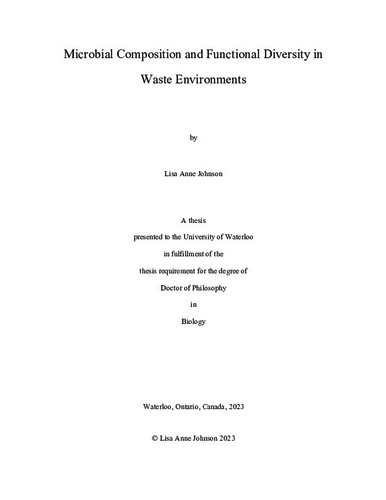| dc.description.abstract | Landfilling remains the most common endpoint of discarded waste. At landfill sites, waste is transformed and degraded by microbially mediated processes conducted by different trophic groups, comprised of members of a heterogeneous and diverse microbial community. Resulting metabolic products from these processes commonly include methane (CH4) and carbon dioxide (CO2), potent greenhouse gases (GHGs), leading to concerns about the long-term efficacy of landfilling as a waste management practice. These concerns arise over the increasing amount of waste being generated worldwide that will place a strain on landfills and, therefore, impact the level of contamination from landfill sites to the environment, particularly regarding emissions of GHGs. These climate change challenges at landfill sites are exacerbated by the limited understanding of the microbial community composition and functional diversity that are present in these heterogeneous ecosystems. Investigating the functional potential of microbial communities with omics technologies, such as metagenomics and metaproteomics, can clarify microbial lineages and processes impacting waste decomposition, stability, and greenhouse gas management.
This thesis examines microbial populations and their metabolic capacities using metagenomics, with a focus on waste management sites and anoxic environments. First, the microbial community within landfill-associated disruptive biofilms was investigated using a multi-omics approach (Chapter 2). Both 16S rRNA gene profiling and metagenomic datasets identified major biofilm phyla as the Proteobacteria, Firmicutes, Desulfobacterota, Campylobacterota, and Bacteroidota. However, the community composition across biofilm samples was very uneven, and varied at the genus-level across biofilm samples. Metaproteomics showed microbial lineages highly abundant in genomic datasets were frequently not the most active. Each biofilm sample had unique keystone species that were detected at low abundances in the genomic DNA, but comprised relatively large proportions of the metaproteomic dataset. The most abundant MAG in Biofilm 1 (BF1) from the protein data classified to genus Pseudodesulfuromonas (phylum Desulfobacterota), and the most abundant MAG in Biofilm 2 (BF2) was classified to genus Methanothrix (phylum Halobacteriota). In Biofilm 4 (BF4) the genus Thiothrix represented 0.2% of 16S rRNA gene sequences and the MAG Thiothrix BF4 Bin 143 accounted for 0.2% of total coverage in MAGs, but made up 33.7% of the total normalized abundance of proteins identified from BF4, highlighting this bacterium as highly active. Evaluation of the proteins at the highest abundance in each sample revealed methyl-coenzyme M reductase and adenylylsulfate reductase as proteins common to each biofilm. Methane and sulfur cycling were important processes occuring in each biofilm and are potential targets for biofilm disruption.
As an enigmatic phylum with representatives found at landfill sites, the distribution and metabolic capacity of phylum Cloacimonadota was examined (Chapter 3) based on detection in the biofilm samples in Chapter 2. Cloacimonadota were abundant and diverse within metagenomic datasets from a municipal landfill, including biofilm metagenomes. A total of 24 new metagenome-assembled genomes (MAGs) were generated, expanding publicly available genomic datasets (30 genomes) by 80%. Cloacimonadota genomes were examined through phylogenetic relationships, metabolic capacity, and pangenome dynamics. Phylogenetic placement of genomes resulted in two distinct clades segregated by ecosystem. Clade I contained all genomes derived from engineered ecosystems, and Clade II contained the majority of genomes derived from environmental ecosystems. Metabolic reconstructions predict Cloacimonadota to be anaerobic and acetogenic, with mixed fermentative and anaerobic respiration lifestyles for the majority of Cloacimonadota surveyed. Genomes from engineered ecosystems encode a suite of genes not typically found in genomes from natural environments, including acetate kinase, genes for cysteine degradation to pyruvate, an increased diversity of carbon utilization enzymes, and different mechanisms for generating membrane potential and ATP synthesis. This phylum-level examination also clarifies the distribution of functions previously observed for members of the phylum, demonstrating that propionate oxidation and reverse TCA cycles are not common components of Cloacimonadota metabolism.
Landfills contain heterogeneous and diverse habitats for microorganisms, and this includes both oxic and anoxic microenvironments. Therefore, microorganisms require mechanisms to manage damaging reactive oxygen species (ROS). To understand the distribution of enzymatic defenses against ROS, genomes spanning the domain Bacteria derived from diverse environments were surveyed for ROS defenses (Chapter 4). The diversity and distribution of enzymatic defenses were reviewed using peer-reviewed literature and publicly available genome databases. Distribution of bacterial genomic capacity for enzymatic ROS defenses did not identify gene complements that would allow for prediction of lifestyle (anaerobic or aerobic), or unique patterns of enzymes within and between bacterial phyla. Instead, the emerging trend was that many different strategies are employed. Further, specific strategies used by well-characterized organisms are described to highlight different oxidative stress responses by organisms using aerobic, facultatively anaerobic, and anaerobic lifestyles. The research in this thesis uses metagenomics as the methodological approach to describe microbial diversity and function. The use of metagenomics enabled the first description of landfill-associated biofilms, with a focus on microbial diversity and key metabolic processes, and additional examination of the enigmatic phylum Cloacimonadota and the distribution of ROS defenses in domain Bacteria. | en |

